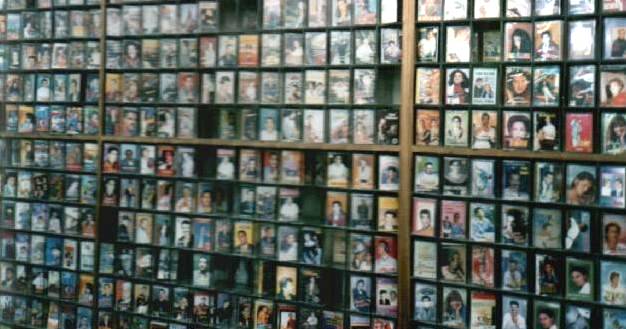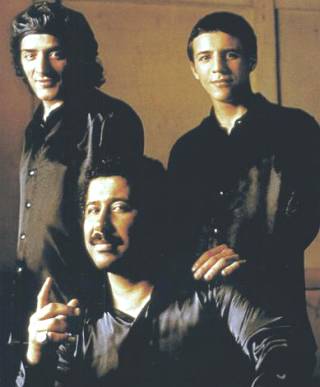| Raï music is considered here - as opposed to other
Maghrebi and Algerian music styles existing in France
- for the following reasons: a) raï music is a
transversal musical style; b) the phenomenon of
immigration has deeply influenced raï music; c) raï is
an internationally commodified music inside the World
Music genre; and d) many beurs and Algerian
immigrants (for different reasons) have told me that raï
represents their identity, which is in my view the most
important motivation for selecting this repertory in the
context of this article. Since the first days of my fieldwork I realized that raï music is a heterogeneous repertoire. For instance, in Parisian music-shops and stores I found, alongside, Chikha Rimitti's, Cheba Zahouania's, and Cheb Hasni's raï, from Cheb Kahled's first album to the Khaled's (without Cheb) last (3), Cheb Mami, and Cheb Faudel’s and Cheb Rani’s raï-beur. It should be underlined that these styles of raï are very different from each other but that every style (even the oldest) (4) is sung, produced and listened to even now. What is the cause of such a large differentiation? How can all these many different styles and genres be identified as raï music? Which process allows that?
I have considered raï’s history more than once, in order to answer these questions (5). During the whole history of raï both emigration/immigration and cultural contacts have played important and constant roles, giving rise to raï’s heterogeneity. It remains to be explained how these dynamics work and why the different styles - even if they are clearly not equally popular - have not replaced each other during their historical process (6). One of the first anthropologists to study cultural contacts and their dynamics was Herskovits (1958). He defined the dynamics of cultural contacts as 'acculturation.' Alan P. Merriam, who was his student, drew on this concept in his The Anthroplogy of Music (1964: 303-319), using it as one of the instruments for the study of music from an anthropological point of view. Margaret Kartomi, in an article (1981: 227-249) devoted to the dynamics of cultural contacts, developed the concept of 'musical transculturation' by starting from the previous concept. Kartomi highlights how "the most acceptable term with which to refer to complete cycles of positive musical process set in motion by cultural contact - as opposed to the result of contact - is musical transculturation" (Kartomi 1981: 234). Therefore, the term 'musical transculturation' indicates only the processes and mechanisms set in motion by cultural contact. A phenomenon of musical transculturation shows this type of characteristics:
We may use the concept of musical transculturation in order to better understand the development of raï. Emigration - both to Algerian cities (as in the first phase of raï's history) and abroad -, as well as colonialism - which has increased the opportunities for cultural contacts -, and contact with French culture have had an influence on the transformation of raï music. From time to time raï singers have accepted and used alien and foreign musical concepts to produce new styles. In conclusion, since the process of musical transculturation may happen more then once (Kartomi 1981: 245), raï musical styles can be considered the result of different processes and phases of musical transculturation. What is interesting is that each phase exists even today. This is possible because each style up to now has been recognized as a marker of selfhood by a group of people (what will be called below a sound group): in fact, different Algerian audiences have accepted one of these new styles as representative of their identity (Virolle 1995: 37-76, Daoudi and Miliani 1996: 37-86; Poulsen 1999: 19-38, Daoudi 2000). Today, the most recent, and maybe the most influential external cause of raï’s musical transculturation is its international commodification and marketing as World Music (Marranci 2000). The relationship of raï music with the musical market is not a recent event. During the 80s the great diffusion of cassettes of raï music (Langlois 1996: 259-273; Poulsen 1999: 38-74) has deeply influenced this repertoire and has worked to transform raï music (that happened in particular with the production of Cheb Hasni’s raï style). However, over few years the commodification of this repertory has been carried out by the most influent and powerful record companies. In this way raï music has been involved in a process which Breen defines as 'cultural mobility.' Breen explains that "Music is moving rapidly into fresh areas. Likewise, the corporations that own and control the music business are strategically using music to develop new markets for consumer products, while developing new products. I call this cultural mobility" (1995:422).
Not only were both the environment and the singing style of the singers changed (7), but the music was also played by a large Egyptian orchestra. Major record companies do not limit themselves to changing and modifying raï’s performance but often make raï musical experimentation easier. Sometimes they even create new raï styles such as the album Sidi Mansour (Absulute Records 1994) by Chikha Rimitti. This album is a reworking in a rock version of some of Rimitti’s old songs.
This case shows that a singer is not always connected with a single stage of raï's transformation. Certainly, as each process of musical transculturation has taken place in chronological order, some artists have become linked with (or people have linked them with) a particular raï style. Despite this, raï singers can select existing raï styles according to their aesthetic taste and even mix them in the same CD. Therefore, albums such as Khaled by Khaled or Saïda by Cheb Mami can include song styles that are very different from each other.
Different raï styles may exist concurrently in one place (such as Barbès) since each style from a particular stage of musical transculturation needs to be recognized by a large group of people who select it as marker of its selfhood. Therefore, at Barbès all the different raï styles are present because they are all recognized by at least one group of people. |

